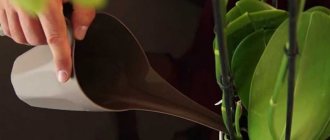» Signs » House plants die in the house: why does this happen according to signs
0
1461
Article rating
The living inhabitants of the apartment are a reflection of what is happening in the house. And it's not just about care. Plants are sensitive to any changes in the energy background. Nature itself gives clues that can help and even save lives. The main thing is to be attentive and not brush aside the signs of the Universe.
Excess fertilizer
Potted flowers are grown in industrial conditions. Plants are overfed with various chemicals. Here is a list of the main macro- and microelements, an excess of which has a negative effect on the flower.
Nitrogen
There is a sharp jump in growth activity, with the formation of an abundant number of short and long shoots. Leaf blades densely cover the plant. Greens and juicy buds attract pests and fungus.
Potassium
Lightened areas are noticeable on the foliage. Leaf blades located next to the soil acquire a gray or gray-green tint. The plant does not develop and dies.
Phosphorus
The leaves become deformed and turn yellow. There is a weakening of growth activity.
Calcium
The foliage tissue dies, and then the root system withers.
This problem can be solved if, after purchasing the flower, the flower is transplanted into another soil. At the transplanting stage, the roots are thoroughly but carefully washed.
If you gave lilacs
Cut lilacs will remain blooming and fragrant if you follow four rules.
- Slice It is better to make it “long” and split at the end.
- Water. Lilac prefers an acidified environment. Add a teaspoon of vinegar or half a teaspoon (without a slide) of citric acid per liter of settled water.
- Spraying. Must be done at least twice a day.
- Overnight. At night, generously spray the lilac and “wrap” it in wet paper. Now you need to move the vase to a cool place.
If the lilac begins to lose its tone, then use the “reanimation” recipe for chrysanthemums. But keep the stems in boiling water a little longer - 15-20 seconds. Now move the bouquet into a vase with cold water, spray and wrap the flowers in wet newspaper for one to two hours.
Video on the topic
Bad pot
Store-bought flowers grow in planting containers. They are then transported in paper. After arriving at the flower stall, the plants are placed in pots. Unscrupulous sellers plant the flower in a new pot without removing the packaging. The roots stop developing and the plant dies.
Store pots are “temporary homes” for plants. They are not suitable for normal cultivation. Small containers are too cramped for the root system, and large ones speed up the rotting process.
How to revive a bouquet of flowers
If the flowers were not stored correctly or were not placed in water on time, their heads droop and look limp and lifeless. You can return them to their previous appearance in the following way.
To resuscitate a fading bouquet, it is freed from the wrappings and ribbons holding the stems together and immersed for several hours in a basin or bath of ice water, leaving only the buds on the surface. Then placed in a regular vase. You can also wrap the flowers in a damp cloth and place them in the refrigerator for several hours.
Poor soil
The majority of manufacturers are trying to save money. Flowers do not receive quality nutrition from the soil. Very often, plants are grown in sand, peat, and transported in perlite, vermiculite, coconut fiber, and plain paper. Infertile soil is watered abundantly or dried out.
If the soil is too dry, the plant will die. Overwatering promotes the formation of mold in the root system. The roots of the flower gradually die off during delivery to the store, and if planted incorrectly in a pot, they die. A customer brings home a dead plant.
Sometimes in greenhouses the soil is not replaced with new soil. A new batch of flowers is grown in the same soil. Gradually it is depleted, loses all nutritional properties, and becomes useless.
TOP 10 most important reasons why your bouquet withers quickly
Surely you have often encountered the problem that a purchased or gifted bouquet does not last long and quickly fades.
However, there are reasons that affect the viability of the bouquet. FAILURE TO COMPLY WITH THEM may result in your flowers quickly going to the trash.
1. HAVING BUYED A BOUQUET, YOU LEFT IT WITHOUT WATER FOR A LONG TIME
If you remain without moisture for a long time after purchase (more than 30 minutes), the flowers, alas, will die faster.
SOLUTION: if you know that you will have to travel with the purchased bouquet for more than one hour, ask the florist to make an aquapack (this is a special package that is filled with water; it’s like a temporary replacement for a vase)
2. WHEN YOU BUYED FLOWERS, YOU PUT THEM IN THE CAR IN THE FREEZE OR HEAT
Flowers are living, this truth allows us to understand why they tolerate extreme conditions so poorly, for example, hot weather or frost.
The optimal temperature for most cut plants is 4-8 degrees C.
The higher the temperature, the faster the processes of rotting and decomposition take place, which means the bouquet dies faster.
In a closed car left, say, in a supermarket parking lot, the temperature can reach 50 degrees or higher. In such conditions, the bouquet will die very quickly. Literally in an hour.
The same applies to frost. Even short-term exposure to negative temperatures is detrimental to delicate plants.
3.YOU BUY FLOWERS IN AN UNVERIFIED PLACE, IN SPOTLIGHT MARKETS
Still, you need to trust the florist. If you buy flowers from the same place, you most likely already know whether they have good flowers, whether the bouquets are fresh, or whether the composition is stable. Stationary stores value their reputation and will not give you a stale flower.
If you buy in a new place, think about the fact that if something happens, you will not make any claims against your grandmother, just like against those who sell, say, from a car.
4. WHEN BRINGING THE BOUQUET HOME, YOU DIDN’T CUT THE STEMES BEFORE LOWERING THEM INTO THE WATER
It seems, what difference does it make whether you cut the stems or not? Moreover, it’s such a hassle!... Especially if the bouquet is large.
But in fact, it is vital!
The fact is that the capillaries located in the stems of flowers and conducting water to the buds become clogged with air bubbles. These bubbles prevent water from flowing freely to the buds. As a result, the buds drop.
SOLUTION:
To allow the flower to drink, you need to cut at least 1 cm of the stem and immediately place it in water.
5. YOU LEFT THE BOUQUET IN A DRAFT, NEAR AN OPEN WINDOW OR NEAR THE RATTER
In a draft, flowers quickly become weathered and die; a sharp change in temperature at home and outside the window is also destructive. And the heat from radiators (during the heating season) shortens the life of flowers several times!
SOLUTION: Look for the coolest place for your bouquet, away from radiators, drafts and direct sunlight.
6. IN THE STORE YOU WAS GIVEN A SPECIAL BAG WITH YOU. MEANS FOR EXTENDING THE LIFE OF FLOWERS. BUT YOU DO NOT USE IT, PREFERING “PEOPLE” METHODS.
The fact is that traditional methods are methods of help with unproven effectiveness, which have more of a “just to do something” effect.
Special studies prove that neither sugar, nor vodka, nor even whiteness will help your roses stay fresh for a long time.
SOLUTION: only fresh water and specially developed products for extending the life of plants will help you preserve your bouquet longer.
7. YOU DO NOT CHANGE THE WATER IN THE VASE, YOU DO NOT WASH THE VASE.
This is fraught with the fact that putrefactive bacteria multiply in dirty water, the bouquet becomes infected with them, which means it dies faster.
SOLUTION: Change the water and wash the vase once a day, while cutting the stems on an oblique.
8. There are fallen leaves lying in the water where your bouquet stands.
This also pollutes the water, which means your bouquet will last less.
WHEN YOU CAME HOME, YOU THROWED OUT ALL THE PACKAGING
Packaging is divided into 2 types: transport (the same aquapack described above) and decorative. Feel free to throw away the first one when you arrive home, but it’s better to leave the second one.
The fact is that decorative packaging is PART of the composition. By removing it, you will deprive the bouquet of zest! In addition, such packaging is often designed to hide technical details and nuances, for example, flasks. By removing the paper, you expose the technical part, which in no case should be visible.
SOLUTION: If you don't want frills on your flowers, ask your florist to simply secure the place where the bouquet is assembled with ribbon. And everything that needs to be hidden will have to be covered not with beautiful paper, but with greenery (which will increase the cost of the bouquet, but you won’t have extra packaging)
Deciding to worry about the safety of the bouquet, you decided to put it in the refrigerator overnight.
Next to the sausage and fruit.
And in the morning it turned out that the bouquet no longer smelled like flowers. And its appearance is not as beautiful as we would like.
Why? The fact is that smoked meats and fruits produce ethylene gas. This gas promotes the rapid opening of buds and the rapid withering of plants. Therefore, the proximity to the refrigerator has not been canceled.
SOLUTION: if you need to keep the bouquet in its original form at all costs (for example, tomorrow you are going to visit and will give it as a gift), think about a cool place. A garage or basement is perfect. The refrigerator is also a great place, but then remove the fruits and smoked foods.
Here is a list of 10 critical barriers to the longevity of your bouquet. Remove them and your flowers will delight you longer.
Still have questions? Call us +375 33 393-93-93
Improper care in the store
The negligence of the seller is another reason why the flower quickly dies. Improper care consists of the following nuances:
- damage to roots during transplantation;
- abundant watering;
- cutting buds and leaves, which are important for further growth;
- dampness;
- not careful loosening;
- feeding with unknown substances.
Typically, sellers rely on a quick sale of indoor plants and do not pay due attention to them. Therefore, the buyer purchases a diseased or lifeless plant.
Improper care after purchase
Flower growers, especially beginners, neglect the advice of sellers and specialists. The Internet is filled with “miracle recipes” that promise dense vegetation for several years. It is a mistake to trust such advice, much less use it in practice.
There are many ways to help a flower from a store find lush greenery and beautiful buds. They consist of the following actions:
- After purchase, the plant is transplanted into a more suitable pot. The dimensions of the pots must correspond to the height of the stem and the width of the leaf blade;
- The roots are carefully washed and the flower is placed in fertile soil. The soil is selected based on the type of plant. If you do not change the industrial soil to soil rich in nutrients, then earthworms and pomurs will appear in the pot;
- eliminate the impact of drafts, dampness, and high temperatures on the sprout;
- apply preventative measures in pest control. It is enough to bathe the plant in the shower once a week.
If the florist does not have experience in growing indoor flowers, then you can consult with more knowledgeable people. Often among friends there are lovers of ornamental plants who have a full-fledged garden in their home or country house.
To divorce
It was already said above that indoor flowers feel the energy of the house and its owners. If one of the spouses decides to leave the family, this is not always immediately noticeable. The appearance of a rival changes the man’s aura, to which the plants begin to react. As a rule, the buds wither first.
If the situation is critical, then the flowers die.
But it is worth paying attention that only those who are in the marital bedroom will give a reaction. After all, when there are problems in the family, intimate life suffers first.
As one thinker said, love is the desire to touch. And although there may be intimacy, it is only instinctive. If you notice the signal in time, you can still save your marriage.
Pests and diseases
Flowers attract various pests. Like other living organisms, a plant can suddenly become ill. Here are a few ailments that are considered the most common.
Powdery mildew
The reasons are high humidity and attacks by insects and mites. Symptoms are the formation of a dense white coating on the leaves and stems. The plaque contains fungal spores. The disease is treated with special fungicides.
Sticky leaves
Reasons: scale insects, false scale insects, aphids, mites or whiteflies have settled. Symptoms - leaves on the hands leave sticky marks - waste products of pests. It is recommended to treat the plant with insecticides and acaricides.
Dry leaf tips
Reasons: watering with hard water, excessive moisture or drying out of the soil, improper fertilizing, high room temperature, cramped pot. Additionally, the plant is inspected for the presence of pests. The type of treatment is selected taking into account the cause of the appearance of dry yellow leaves.
The most dangerous pests are: aphids, mites, whiteflies, weevils, cicadas, caterpillars, scale insects, red spider mites, woodlice, centipedes and miner flies. Chemicals for killing insects are sold in hardware stores. The best way to treat a plant is to prevent the appearance and reproduction of insects.
To ensure that the purchased flower remains strong, healthy and beautiful, it is enough to follow simple preventive measures. Moderate watering and timely fertilization, maintaining a comfortable temperature in the room, regular pruning and replanting are the main requirements aimed at the favorable development of the flower.











